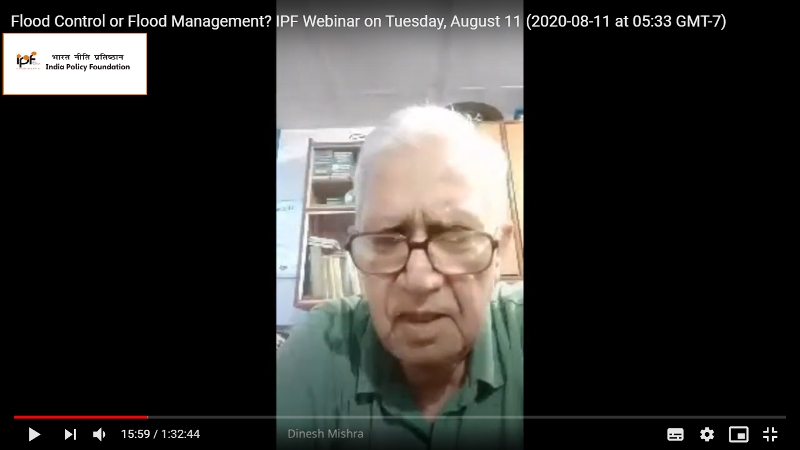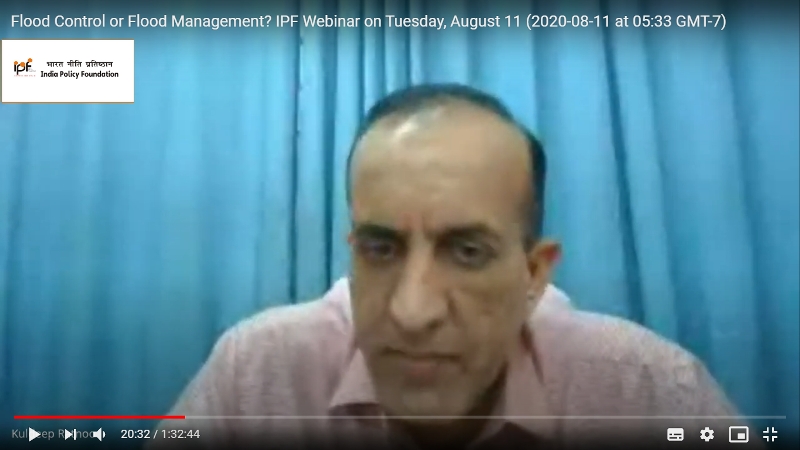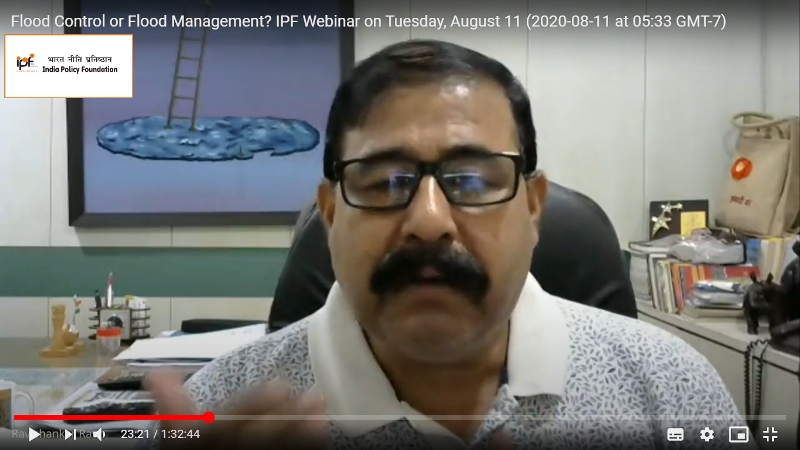IPF Webinar on “Flood Control or Flood Management”
Total Views |
IPF Webinar
on
“Flood Control or Flood Management”
August 11, 2020
Floods have been causing widespread destruction in India for the past several years. In many parts of the country, it is seen as an annual affair with little discussion on whether the flood situation can be handled better.
In a webinar organized by India Policy Foundation, the issue of “Flood Control or Flood Management” was discussed in detail and some pertinent observations were made by the experts.
The speakers were Dr Dinesh Kumar Mishra, Convenor, Barh Mukti Abhiyan and Shri Ravi Shankar Ravi, Editor, Dainik Purvoday, Guwahati. The session was moderated by Dr Kuldeep Ratnoo, Director, India Policy Foundation.

Dr Mishra set the tone for the discussion by explaining that whenever excess water interferes with normal life, it is classified as floods. For centuries, people settled near the rivers and adjusted with the floods. However, with the advent of modern technologies and engineering, we forgot to manage with the floods, and instead started taking steps to temporary halt or divert the flow of water, without knowing any permanent solution to floods.
He remarked, “while trying to teach a lesson to nature, we are being taught several lessons. Instead of discarding traditional wisdom, we should ask our elders for advice to understand how our ancestors used to handle floods”.
He said every time a flood comes to north Bihar, it is wrong to assume that it is because Nepal released the water. He pointed out that for water to be released, it is necessary to store the water at some place and Nepal has no mechanism for storing excess water.
“By blaming Nepal for the floods, the authorities in India want to convey that the problem of floods do not arise from India because of which a solution cannot be found,” he said.
He recollected attending a meeting where the Secretary of Water Resources Ministry had also come. In that meeting the Secretary had accidentally admitted that considering the speed of progress on talks between India and Nepal, it would take atleast 60 more years to build a dam in Nepal.
Dr Mishra opined that the authorities have been at fault. Giving an example, he said, “In order to reduce the flow of water, they constructed check damswithout taking into account the sediments that will get deposited. Then they constructed sluice gate along the river’s channels because of which water level kept rising and it flooded the adjoining areas. So, it was one bad policy decision that set off a chain.
In addition to this, he added that the contractors are not to be blamed for any of this as they are “earnest” in their work. He said, “The contractors are always very sure that they are in this business to earn money unlike others who preach social good but act according to their vested interests. They are ready to build dam or bridge or embankment, as per your tender. I feel this whole issue is political. There is no accountability on the part of the government and other authorities. We need to accept the fact that we interfered with the course of the river and it was not the river that came in our way.”
Elaborating on this point, he said, “Earlier, floods never used to last for more than three days and floods used to be unheard of in cities. We need to think about how we came to this state. We wanted to teach nature a lesson by controlling it. But as it turns out, we are the ones who are being taught some very difficult lessons by nature. Even now when we talk about flood management, what we are doing in effect is flood control.”
He pointed out thatbefore independence, the flood prone area in Bihar was 25 lakh hectares, but today it is 65 lakh hectares. Out of this about 9.5 lakh hectaresget completely submerged because of which no agricultural activities can be carried out.
He stressed that it is important for the authorities the need to take into account the realities on the ground. “Relief measures cannot be a permanent solution. No development will take place when the focus becomes solely on compensation. The government definitely understands the magnitude of this problem but they keep pacifying the public and move on without addressing the root cause of the problem,” he added.
Talking about a possible solution, he put forth a suggestion to institute a Drainage Commission to look into the issue of annual floods in both cities and villages. Once this is established, he said, “The problem will be how to bring the people in establishments across a table?The second is, when we are sitting across the table, what will our demands be? We need to keep debating on these issues for solutions to emerge.”
Dr Ratnoo in his remarks said, “The effects of floods linger on long in society. It stops livelihoods, destroys assets and the normalization process takes a long time. Earlier it used to affect only a few thousands but now millions are affected by floods every year with the flood water taking close to one and a half months to recede in some places.”
Shri Ravi began his talk by comparing the situation when he first came to Assam in 1989 to the present. He observed that the frequency of floods has increased and so has destruction. To understand why this is happening, he went to Dhemaji from where the flood beginsand spoke to the elderly on how they used to handle the floods. They told him that earlier they used to know that floods were coming when the water starts changing colour and they would start preparations for going to higher altitude areas to save themselves from the flood. Floods can come anytime from mid-April to mid-October. And this year floods have come thrice which is a rarity. Second factor is that the houses they stay in are at least 10 feet above the ground level. They rear their cattle below the stairways when there is no flood.

Focusing his attention on Brahmaputra and on China building a dam, he said, there is misconception that if a dam is built on Brahmaputra, then water flow to India will be stopped. It is not possible as a number of rivers merge in Brahmaputra. The real issue here is the increased silting in Brahmaputra and the subsequent rising of the river bed. The main reason why this has happened is illegal, unscientific sand mining.
ShriRavi pointed out that to address these issues,the Brahmaputra board was constituted in 1980 through an Act of Parliament. The main aim of this board was to help control and manage the floods. It was a political demand. Thousands of crores were spent on this project especially on Majuli which also forms a civilizational part of Assam. But in Assam, the “politics of check dam” is there to serve a political agenda and does not go beyond that. Check dam is a major medium for corruption in Assam.
He lamented that the problem with constructing so many check dams is that it becomes impossible to maintain them.“Within four to five years of construction, the check dams start breaking. And when check dam is constructed in one area, it results in water rising in some other area. The truth is that you cannot stop floods with check dams. The end result is that the Brahmaputra Board that was launched with high expectations is now defunct. It is nothing but a white elephant now,” he said.
About Kaziranga, a region that often gets ravaged by floods, he said, “As far as Kaziranga is concerned, the annual floods are necessary for the survival of the rhinoceros (Gainda) as bamboo shoots thrive when the old mud is replaced with the new. Floods also clean out the jungles. In Assam, absence of floods will lead to scarcity of food.” The flood waters help fill the water bodies which contributes to pisciculture, agriculture and grazing.
Pointing to an interesting method adopted by the people to manage floods in Assam, he said, “This time, I saw that a number of mounds (teela) were built-in low-lying areas which gave shelter to the wild animals from the floods. Instead of check dams, more such mounds have to be built. There has to be permanent relief centres in areas that regularly get flooded.”
While arguing that it is always better for floods to be managed than controlled, he cautioned that check dams are a necessity in places like Dibrugarh due to extensive damage caused by earthquakes. “In such densely populated areas, check dams are important. But in low lying areas where the population density is less, check dams have wreaked havoc. If practical measures are taken to manage the floods, the situation can be brought under control.” He added thatthe multiple dams in Bhutan have also been contributing to the floods in Assam while nobody is aware of what is happening in China.
“A strategy needs to be evolved on how to manage floods effectively. Floods can never be controlled,” he said.
In the question and answer session with participants, Dr Mishra answering a question on whether tall dams can control floods pointed out that tall dams could only be constructed on mountainsbut on plain lands, only an embankment can be built.Because of the topography, Nepal is in a better position to construct such dams. Nepal and India have been working on a report in this regard for the past 33 years but no constructive solutions have emerged. He said,“India will have to find its own solutions and not be dependent on another country.”
Talking about the Interlinking of River programme, he said, there is no water in south Bihar and interlinking of rivers will have to address those primary issues first.
“We need to understand the signs from nature when the rivers try to change course and we stop it from happening,” he opined.
Going back to his demand for a Drainage Commission, Dr Mishra said, “There needs to be good drainage system for the water to enter as well as leave during floods. First, we should take a cluster of villages and implement policies effectively. A long battle will have to be fought and public awareness will have to be created on a large scale to look beyond relief measures.”
Elaborating further, he said, “Due to construction of roads, it was obvious that one day there will be water logging. It will destroy agriculture in the low-lying areas. There is no accountability and it increases the scope for corruption.” He added that there is no technology that is being used anywhere to manage the flood situation in the country.
Making a very pertinent point, he said, the reason why Drainage Commission was never appointed was probably because the government had to accept that its flood control policy was wrong.
Talking about the solutions for flood management, Shri Ravi Shankar said, “We need check dams only in places where it is absolutely necessary. It is important for floods to come. It enhances fertility of the plains and maintains the ground water level.”

He stressed thatour education system needs to change to spread more awareness on how development should be based on needs and historical knowledge. He urged that we should stop aping the West and we should include in the school syllabus on how people used to manage floods before.”
Dr Ratnoo in his concluding remarks said, “We should search for local solutions in our villages and we should find ways according to the needs of each region. ‘One size fits all’ approach won’t help. We need social engineering with civil engineering.”
(Report prepared by Lekshmi Parameswaran. Inputs by Vikrant Tyagi)